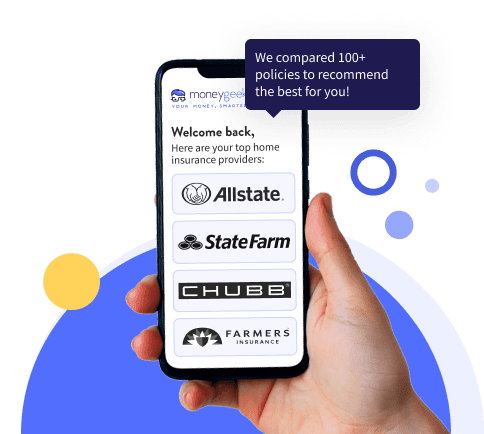Hazard insurance covers damage to the home’s structure or pays to rebuild the house in case of a total loss. It does not pay for damage to, or total loss of, your personal belongings, nor does it cover injuries suffered by visitors to your home.
Hazard Insurance: What Is It & How It Differs From Home Insurance?
Hazard insurance is included in a standard home insurance policy and covers only the home's structure. It's not a separate policy from home insurance.
Find out if you're overpaying for home insurance below.

Updated: May 11, 2025
Advertising & Editorial Disclosure
Key Takeaways
If you need hazard insurance, then you likely need a standard homeowners policy.
Hazard insurance provides coverage specifically to repair or rebuild your home.
You cannot purchase hazard insurance as a standalone policy.
Compare Home Insurance Rates
Ensure you're getting the best rate for your home insurance. Compare quotes from the top insurance companies.
What Is Hazard Insurance?
Hazard Insurance Requirements: What You Need
Your mortgage company may require a specific type of hazard coverage, meaning what hazards it will and will not cover, a minimum amount of coverage on the home, and a specific deductible you are required to pay. Once you have your homeowners insurance policy, your mortgage company will want proof of this insurance to confirm you have hazard insurance.
Why Do I Need Hazard Insurance?
Because mortgage companies are lending you the money to pay for your home, they want to make sure their investment is protected. Therefore, they will ask for hazard insurance because that is the segment of your homeowners insurance policy that covers their investment: the home itself.
Although a typical homeowners insurance policy also includes coverage for personal belongings and potential liabilities, the mortgage company is only concerned with the hazard insurance coverage.
How Much Is Hazard Insurance?
Insurance providers examine many factors to determine the cost of your policy. Many factors relate to the home itself, but others relate to you as the policyholder. Below are some of the most common factors insurers consider.
- The age of the home
- The type of home structure, such as brick, stucco or wood
- The type of roof, such as slate, metal or composite shingles
- The square footage of the home
- The home’s safety features, like systems, smoke detectors and fire extinguishers
- The home’s location
- Your credit history
- Your homeowners insurance claims history
- Any gaps in your insurance coverage
Because each insurance company develops its list of criteria for evaluating policy rates, this is not a comprehensive list of every factor under consideration. However, it does give you a good idea of what to expect when speaking with insurance companies.
Average Hazard Insurance Cost
The cost of a hazard insurance policy varies per person. On average, it can be between $1,671 and $2,054 per year, depending on the insurance provider.
Company | Dwelling Coverage $250K and Personal Property $50K |
|---|---|
Allstate | $1,671 |
Chubb | $1,676 |
Nationwide | $1,719 |
USAA | $1,800 |
Travelers | $1,850 |
State Farm | $1,946 |
Farmers | $2,054 |
**NOTE: The rates above are averages based on a homeowners policy with $250,000 of dwelling coverage and $50,000 of personal property. Actual rates may differ. Talk with several insurers and compare home insurance quotes based on your specific home and personal factors.
Best Hazard Insurance Companies
Many insurance companies offer hazard insurance as part of their homeowners insurance policies. USAA is MoneyGeek's top pick for hazard insurance. Next is State Farm. Learn more about the best hazard insurance companies below.
**NOTE: Although USAA has the highest MoneyGeek score, it's only available to active military, veterans and their families.
How to Get Hazard Insurance
When purchasing hazard insurance as part of your homeowners policy, insurers will need to know the following about the structure. Specifics may vary, but typically include the age of the home, the square footage, the type of home construction (like brick, wood and stucco, etc.), the type of roof (metal, slate, composite shingle, etc.), any safety features (such as alarm systems) and the location.
Insurance companies will also need information about you. These may include your credit history, history of filing homeowners claims, and whether you have had any insurance gaps.
Compare Hazard Insurance Quotes
Shopping around and comparing quotes from multiple providers will help you get an accurate estimate of your premiums. MoneyGeek's calculator can help readers get a quote in five minutes or less.
Home Insurance
Calculator
MoneyGeek’s home insurance calculator will give you a ballpark estimate of your cost — It's free to use, requires no personal information and we won't send you any spam.
Rates updated:
Jul 03, 2025
Your Next Step:
Get your real quotes from trusted insurance providers.
Although MoneyGeek partners with some of the companies we recommend, our content is written and reviewed by an independent team of writers, editors and licensed agents. Learn more about our editorial policies and expert editorial team.
Is Hazard Insurance the Same as Homeowners Insurance?
Hazard insurance is not a different type of insurance from home insurance. It is the component within a standard comprehensive homeowners insurance policy that covers just the structure of your home. It will pay for repairs if your home is damaged or to rebuild it if it is a total loss. You cannot purchase hazard insurance as a separate or standalone policy.
Hazard Insurance vs. Homeowners Insurance: Differences in Coverage
Hazard insurance, also known as dwelling coverage, covers the structure of your home, including the roof and foundation. The other elements of your homeowners insurance policy provide coverage for other needs. Your comprehensive homeowners policy should also include:
Personal Property
This coverage pays to repair or replace your belongings in the home.
Other Structures
This covers any detached structure on your property, such as a detached garage, outbuildings and fencing.
Liability Coverage
If someone is injured in your home and you are found responsible, this pays your expenses.
Loss of Use
If you cannot live in your home while it is being repaired or rebuilt, this coverage reimburses you for relevant costs like payment for a hotel room and restaurant meals.
Medical Payments
This coverage pays for their medical expenses if someone is injured in your home.
Homeowners Insurance Coverage: Named Perils
Most homeowners insurance policies contain “named perils” coverage, meaning they will pay for damage (or to rebuild your home) provided it is due to one of 16 specific disasters or hazards. This is the most common type of homeowners insurance policy available. The 16 disasters or hazards covered are:
- Fire or lightning
- Wind or hail
- Weight of snow, sleet or ice
- Smoke
- Explosion
- Volcanic eruption
- Theft
- Vandalism or malicious mischief
- Riot or civil commotion
- Damage caused by vehicles
- Damage caused by aircraft
- Falling objects
- Accidental discharge or overflow of water from plumbing, heating or air conditioning systems, a household appliance or an automatic fire-protection sprinkler system
- Sudden and accidental tearing apart, cracking, burning, or bulging of an air conditioning system, a steam or hot water heating system or an automatic fire-protection sprinkler system
- Freezing of plumbing, heating or air conditioning systems, a household appliance or an automatic fire-protection sprinkler system
- Sudden and accidental damage from artificially generated electrical current
Homeowners Insurance Coverage: Open Perils
Choosing an “open perils” home insurance policy will cover most perils or hazards except those specifically listed in the policy. Examples of these exclusions include:
- Flooding
- Earthquake
- Nuclear hazard
- Wear and tear
- Mold, fungus or rot
- Smog
- Government action
- Power failure
- War
- Neglect
- Intentional loss
- Collapse
- Vandalism (if the house is vacant for more than 60 days)
- Theft (if the home is under construction)
- Smoke (not from a house fire)
- Pollutants
- Birds, rodents, insects and vermin
- Animals you own
- Mechanical breakdown
- Settling
Hazard Insurance for Homeowners: Bottom Line
In this article, we explored what hazard insurance is, how much it costs, the best companies and how it differs from home insurance. Hazard insurance is the component in your homeowners insurance that covers your home’s structure. Sometimes referred to as dwelling coverage, it is not a standalone policy but a part of your overall homeowners insurance policy that also contains coverage for your personal belongings and liability coverage.
Compare Home Insurance Rates
Ensure you're getting the best rate for your home insurance. Compare quotes from the top insurance companies.
Hazard Insurance for Home: FAQ
Understanding the difference between hazard insurance and homeowners insurance can be confusing at first, but these frequently asked questions can help clear up the confusion.
Is hazard insurance the same as homeowners insurance?
Hazard insurance is part of homeowners insurance. Hazard insurance covers the actual structure of your home. Homeowners insurance policies, which include hazard insurance, provide comprehensive coverage for your home. You cannot purchase hazard coverage as a standalone policy.
Is hazard insurance required if I own a home?
While no laws require you to purchase hazard insurance, if your home is financed, your mortgage lender most likely will require you to buy it to protect their investment.
Is hazard insurance tax-deductible?
Homeowners insurance, which includes hazard insurance, is considered a personal expense and is not tax-deductible.
What is hazard insurance on a home loan?
As part of a homeowners insurance policy, hazard insurance is coverage that pays for repairs to (or the reconstruction of) your home due to damage or loss.
Do I need hazard insurance if I need homeowners insurance?
You need both hazard insurance and homeowners insurance becasue hazard insurance is a component of homeowners insurance. Hazard insurance, otherwise known as dwelling coverage, is included by default in standard homeowners insurance policies
Best Hazard Insurance: Our Ratings Methodology
To rank the top home insurance companies for hazard insurance, MoneyGeek calculated a unique score for each company using premium data for companies offering service in more than 35 states on average. This data includes J.D. Power for customer service, AM Best for financial stability and Quadrant Information Services for affordability.
MoneyGeek sourced pricing information from Quadrant Information Services to calculate the average cost of hazard insurance on both a state and national level. Using a homeowners insurance policy with $250,000 in dwelling coverage and $50,000 of personal property, the scores are on a scale of 0 to 100 on the national level.
Home Hazard Insurance: Related Pages
About Karon Warren

A long-time freelance writer, Karon Warren covers insurance, finance, business, healthcare and other topics for such outlets as Lending Tree, Bankrate.com, Coverage.com and others. A graduate of The University of Southern Mississippi, she is a member of the American Society of Journalists and Authors.
sources
- Insurance Information Institute. "Homeowners Insurance Basics." Accessed April 18, 2024.


